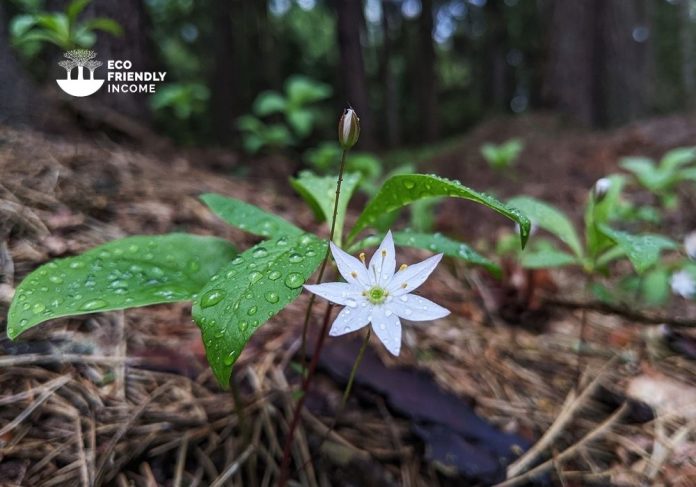A field guide on how to identify and propagate Northern Starflower (Trientalis borealis), a hardy zone 2 perennial wildflower that is native to North America.
How to Identify Northern Starflower (Trientalis borealis)
Leaves
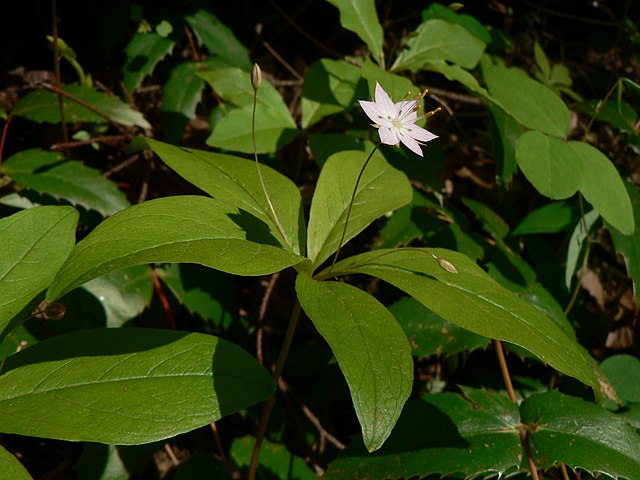
Northern starflower leaves are elliptical to lance-shaped, with a basal to whorled leaf arrangement, and an entire margin (smooth).
Flowers
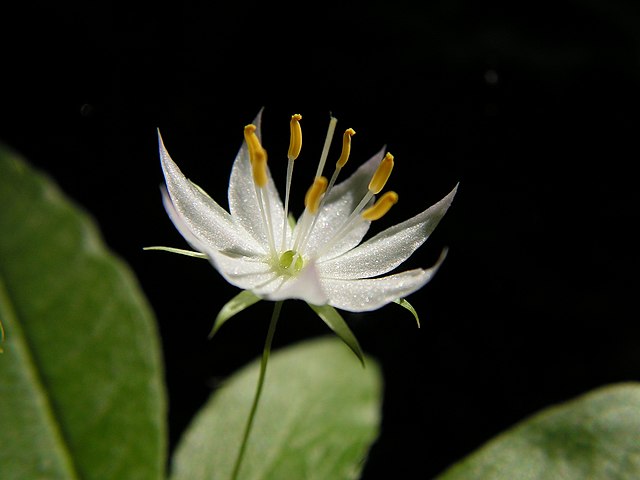
The flower grows on long stalks above the leaves. There are usually 1 to 3 flowers per plant. They are star-shaped and white in color. Each flower has 7 stamens, petals, and sepals. The flowers measure about 2 cm in diameter.
Flowering Season
Northern starflowers usually bloom from late May to June.
Habitat
You can find starflowers in moist woodlands, close to peat bogs or sandy forests where the soil is acidic.
It likes to grow through moss and needles.
If you see some of these plants, there’s a chance you’ll see northern starflowers nearby:
- Bluebead (Clintonia borealis)
- Bunchberry (Cornus canadensis)
- Canada Mayflower (Maianthemum canadense)
Northern starflower can be found growing as north as Yukon in the west and Labrador in the east.
Wildlife Value
Starflowers attract pollinators in the spring, but their small size and lack of abundant fruit do not provide much value for small mammals or birds.
How to Propagate Northern Starflower (Trientalis borealis)
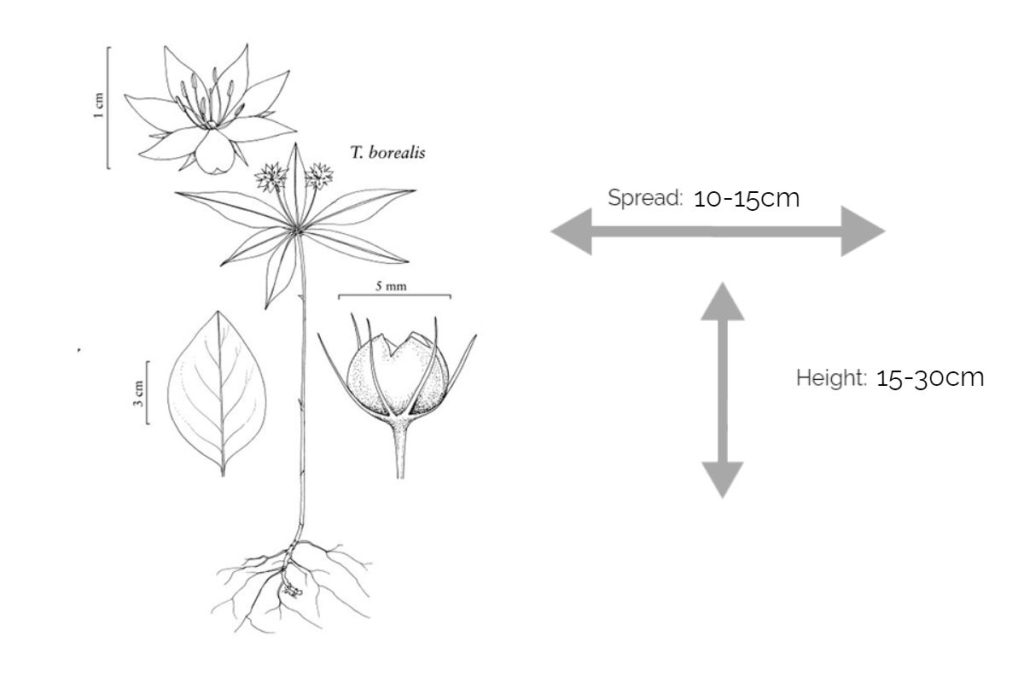

Hardiness Zone: 2-7

Soil Type: Acidic peat, loam, sand.

Water: Normal.

Exposure: Partial to Full Shade.
There are two feasible ways to propagate northern starflowers:
Let’s take a look at both methods:
How to Propagate Northern Starflower (Tirientalis borealis) by Seed
Northern starflowers bloom in spring, and once pollination is successful, the plants will produce seed pods.
The seed pods are singular fruit-like masses that appear on the end of the flower stalks.
Your best bet is to harvest them later in the summer (so they have matured enough), and air-dry them before you extract the seeds.
Alternatively, you can order seeds online at BotanyCA.
How to Sow
Northern starflower seeds need to go through cold stratification to germinate.
You can sow them in the fall outside for spring germination.
Indoors you can cold stratify them in a refrigerator like so:
- Bag them in damp sand inside a ziplock bag, and tag the name and date.
- Place them in a freezer for 60 days, then take them out, and thaw them in room temperature water for 12 hours.
- Rebag them, and place them in the refrigerator for another 60-90 days.
That will successfully cold stratify them, now you can plant them in sand/peat mix, moisten, then cover with a wrap.
Seeds should germinate within a few weeks.
How to Propagate Northern Starflower (Trientalis borealis) by Division
These are herbs with a suckering habit that grow tuber-like roots. This makes division an effective way to propagate northern starflowers.
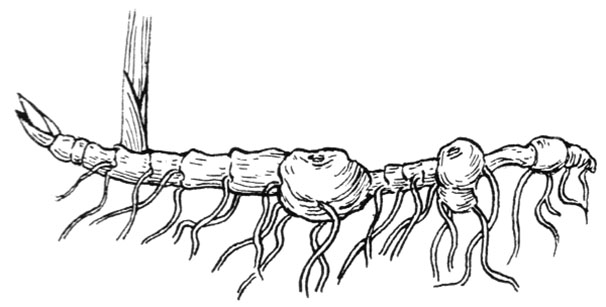
The best time of the year to take rhizome cuttings is early spring or fall, when the plant is dormant.

You do have to be careful though since the roots are quite small, here’s how to do it:
- First, carefully dig around the plant to find the rhizome.
- You can pull the whole plant out, or clip a part of the rhizome with roots on it.
- If you dig out the whole plant, you can split the rhizome into multiple cuttings and plant them. If not, a single cutting can work without killing the plant.
- Next, keep the rhizome cuttings moist for transport.
- Now you want to place them in a container with black peat moss, or live moss works too.
- Place the rhizome cuttings on the soil making sure they’re not upside down.
- Cover with more peat moss (no more than 1 inch), moisten, and finally place in a partly shaded area.
How long until you see a shoot poke up through the moss is dependent on the size of the rhizome cutting and when it wakes.
From here, you just have to keep the propagation medium humid but not soggy.
New shoots coming up does not mean the cuttings are rooting yet. A good year of growth should be given first before transplanting.
FAQ
Q: Where can you find starflower?
A: Northern starflower is found in wet habitats, including boggy forests, swamps, bogs, muskeg, and wet meadows from low to subalpine elevations, although it is less common in these areas further south and at higher elevations.
Q: What does Starflower mean? What do starflowers symbolize?
A: Starflowers are named after the star-like shape of their flowers, they symbolize love, wisdom, faith, and color.
Q: What is the scientific name for northern starflowers?
A: The commonly used scientific name for northern starflowers is trientalis borealis, although it seems to have been reclassified into Lysimachia borealis.

